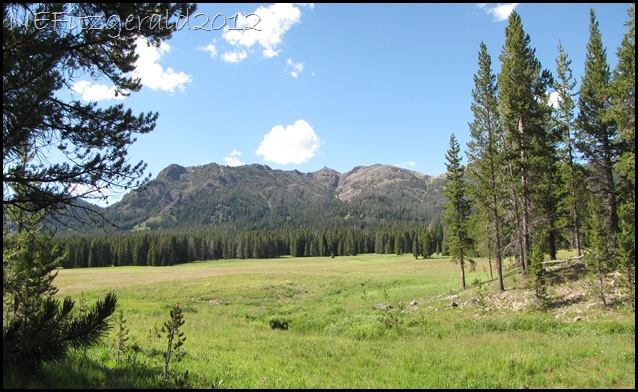At first glance, the springs looked like purple motor oil cascading down the bleached hillside. I had read somewhere that there are small hydrocarbon deposits in Yellowstone, so I wondered if these might be some of those.
 |
| Washburn Hot Springs |
And then there was that indescribable smell…
I don’t even know how to explain the headache–inducing aroma wafting up from the bowels of Washburn Hot Springs except to say it is beyond sulfur stinky. “Rotten eggs” doesn’t even begin to describe that malodorous bouquet of stench emanating from those belching, bubbling, burping ink pots from hell.
What is this stuff?
Since last summer several Grant Village people had talked about hiking to Washburn Hot Springs and now we were finally embarking on our bucket list adventure. Our route would take us up the Chittendon Road side of Mt. Washburn in order to save our knees ½ mile of trail pounding. The total trail guide book distance was supposed to be 10.5 miles which would prove to be a major endurance record (and more!) for me.
 |
| Chittendon Road up Mt. Washburn |
 |
| Photographing the photographer with lookout tower on distant peak |
 |
| Yellow-bellied marmot keeps an eye on our passage |
 |
| Pondering the route from the Mt. Washburn lookout tower |
See that big green meadow so far away? We would soon be hiking across it.
 |
| Grand Canyon of the Yellowstone lies just beyond our big green valley |
After pausing for a snack at the lookout tower we traipsed down the steep, rocky, wildflower–and–bighorn sheep–strewn backside of the mountain on the Washburn spur trail.
 |
| On the back side of Mt. Washburn – views into the Absaroka-Beartooth Wilderness |
 |
| Female bighorn sheep with calves are a common sight on Mt. Washburn |
 |
| Mt. Washburn spur trail – steeper than it appears! |
Crossing that aforementioned big green meadow we glanced back and saw towering Mt. Washburn where we had snacked just prior to our knee–crunching descent down the spur trail. And we still had several miles to go before we reached the springs.
 |
| Mt. Washburn lookout tower is on center distant peak |
The sulfur smell preceded any vision of the springs but eventually they appeared before our eyes.
Jeez this looks like motor oil coming out of the ground! And that smell is beyond overwhelming!
 |
| Steam rises from ink pots at Washburn Hot Springs |
 |
| Steaming ink pots at Washburn Hot Springs |
 |
| Ink pots at Washburn Hot Springs |
 |
| This stuff in the runoff channels looks like motor oil! |
 |
| Boiling ink pots in Washburn Hot Spring |
So what are these ink pots from hell?
According to “Hot Springs of the Yellowstone National Park” by E.T. Allen and Arthur L. Day (published by the Carnegie Institution of Washington in 1935 and found on the shelf of the Grant Village library), the black pigment in these ink pots is a sulfide of iron called pyrite (FeS2). This magnificent text which is nearly the size of a toaster oven also states that on the summit of these hills there are abundant rounded pebbles and boulders of basalt which have “an unmistakable influence on the spring waters and sediments.”
Well, I did not dare poke around on the summit of any of these hills so did not notice any basalt. But according to the text, the occurrence of this pyrite at Washburn Hot Springs seems to be directly attributable to the greater amount of iron in the basalt. Most of the rock found inside the Yellowstone caldera is silica–rich rhyolite, so to find out where there is iron–rich basalt is exciting for a geo–head like me.
Now we know what this stuff is!
It was nearly four miles from the springs back to where we had parked a car and by the time we got there I was so hammered I could barely stand except to kiss the car. Our hike distance was definitely not the trail guide book mileage of 10.5 miles but ended up being 13.59 miles according to our gps. The post–hike ice cream we all enjoyed at Canyon didn’t even begin to cover those calories we burned.
 |
| Only a few miles left on the Seven Mile Hole trail |
 |
| The car! The car! |
The smell of the springs still lingers in my brain, though. I can’t wait to go back one day and poke around those hillsides.






